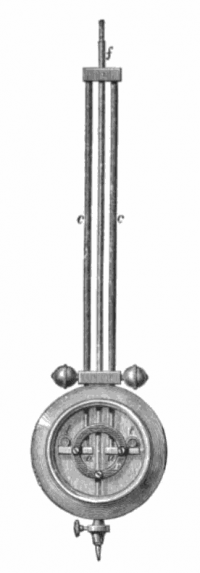Difference between revisions of "Chapter 2: 12-13"
m (→Page 13: spacing) |
Hotratsalex (Talk | contribs) |
||
| (7 intermediate revisions by 2 users not shown) | |||
| Line 2: | Line 2: | ||
'''Needle'''<br> | '''Needle'''<br> | ||
| − | The compass | + | The compass. |
==Page 13== | ==Page 13== | ||
| − | + | '''twin Telescope, by Mr. Dollond'''<br>[[file:Ellicott_pendulum.png|200px|thumb|right|Ellicott pendulum]] | |
| − | '''twin Telescope, by Mr. Dollond'''<br> | + | |
[http://images.google.com/images?svnum=10&hl=en&lr=&q=dollond+telescope pix] | [http://images.google.com/images?svnum=10&hl=en&lr=&q=dollond+telescope pix] | ||
| + | |||
| + | John Dollond (10 June O.S. (21 June N.S.) 1706 - 30 November 1761) was an English optician, known for his successful optics business and his discovery of achromatic doublets. From [http://en.wikipedia.org/wiki/John_Dollond WIKI]. The company is still in business as a chain of opticians in the UK, Dollond and Acheson. | ||
'''Clock by Mr. Ellicott'''<br> | '''Clock by Mr. Ellicott'''<br> | ||
| Line 14: | Line 15: | ||
'''Sector by your Mr. Bird'''<br> | '''Sector by your Mr. Bird'''<br> | ||
[http://images.google.com/images?svnum=10&hl=en&lr=&q=john.bird+sector pix] | [http://images.google.com/images?svnum=10&hl=en&lr=&q=john.bird+sector pix] | ||
| + | |||
| + | John Bird (1709 - 1776) the great mathematical instrument maker was born at Bishop Auckland. He worked in London for Jeremiah Sisson, and by 1745 he had his own business in the Strand. Bird was commissioned to make a brass quadrant 8 feet across for the Royal Observatory at Greenwich, where it is still preserved. Soon after, duplicates were ordered for France, Spain and Russia. Bird supplied the astronomer James Bradley with further instruments of such quality that the commissioners of longitude paid him £500 (a huge sum) on condition that he take on a 7-year apprentice and produce in writing upon oath, a full account of his working methods. This was the origin of Bird's two treatises The Method of Dividing Mathematical Instruments (1767) and The Method of Constructing Mural Quadrants (1768). Both had a foreword from the astronomer-royal Nevil Maskelyne. When the Houses of Parliament burned down in 1834, the standard yards of 1758 and 1760, both constructed by Bird, were destroyed. From [http://en.wikipedia.org/wiki/John_Bird_%28astronomer%29 WIKI] | ||
'''His Ways how strange'''<br> | '''His Ways how strange'''<br> | ||
Latest revision as of 14:22, 25 November 2010
Page 12
Needle
The compass.
Page 13
twin Telescope, by Mr. DollondJohn Dollond (10 June O.S. (21 June N.S.) 1706 - 30 November 1761) was an English optician, known for his successful optics business and his discovery of achromatic doublets. From WIKI. The company is still in business as a chain of opticians in the UK, Dollond and Acheson.
Clock by Mr. Ellicott
pix
Sector by your Mr. Bird
pix
John Bird (1709 - 1776) the great mathematical instrument maker was born at Bishop Auckland. He worked in London for Jeremiah Sisson, and by 1745 he had his own business in the Strand. Bird was commissioned to make a brass quadrant 8 feet across for the Royal Observatory at Greenwich, where it is still preserved. Soon after, duplicates were ordered for France, Spain and Russia. Bird supplied the astronomer James Bradley with further instruments of such quality that the commissioners of longitude paid him £500 (a huge sum) on condition that he take on a 7-year apprentice and produce in writing upon oath, a full account of his working methods. This was the origin of Bird's two treatises The Method of Dividing Mathematical Instruments (1767) and The Method of Constructing Mural Quadrants (1768). Both had a foreword from the astronomer-royal Nevil Maskelyne. When the Houses of Parliament burned down in 1834, the standard yards of 1758 and 1760, both constructed by Bird, were destroyed. From WIKI
His Ways how strange
His = God's.
Imps of the Apprehensive
Allusion to a famous Edgar Allen Poe story, "The Imp of the Perverse"?
Without spoiling that story by telling it, 'apprehension' could be said
to be crucial in it.
